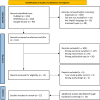Building for the Future: A Systematic Review of the Effects of Eccentric Resistance Training on Measures of Physical Performance in Youth Athletes
- PMID: 37097414
- PMCID: PMC10185653
- DOI: 10.1007/s40279-023-01843-y
Building for the Future: A Systematic Review of the Effects of Eccentric Resistance Training on Measures of Physical Performance in Youth Athletes
Abstract
Background: Eccentric resistance training is recognised as an effective stimulus for enhancing measures of muscular strength and power in adult populations; however, its value in youth athletes is currently not well understood.
Objective: The aim of this systematic review was to critically appraise the effects of eccentric resistance training on measures of physical performance (i.e. muscular strength, jump, sprint and change of direction) in youth athletes 18 years of age and under.
Methods: Original journal articles published between 1950 and June 2022 were retrieved from electronic search engines of PubMed, SPORTDiscus and Google Scholar's advanced search option. Full journal articles investigating the acute and chronic effects of eccentric resistance training on measures of physical performance in youth athletes (i.e. a person 18 years of age or under who competes in sport) were included. The methodological quality and bias of each study were assessed prior to data extraction using a modified Downs and Black checklist.
Results: The search yielded 749 studies, of which 436 were duplicates. Three-hundred studies were excluded based upon title and abstract review and a further 5 studies were removed following the modified Downs and Black checklist. An additional 14 studies were identified during backward screening. Accordingly, 22 studies were included in our systematic review. The Nordic hamstring exercise and flywheel inertial training were the most frequently used eccentric resistance training methods in youth athletes. Improvements in physical performance following the Nordic hamstring exercise are dependent upon an increase in the breakpoint angle, rather than training volume (sets and repetitions), and are further elevated with the addition of hip extension exercises or high-speed running. A minimum of 3 familiarisation trials is necessary to elicit meaningful adaptations following flywheel inertial training. Furthermore, an emphasis should be placed upon decelerating the rotating flywheel during the final one to two thirds of the eccentric phase, rather than gradually throughout the entire eccentric phase.
Conclusions: The findings of this systematic review support the inclusion of eccentric resistance training in youth athletes to improve measures of muscular strength, jump, sprint and change of direction performance. The current eccentric resistance training methods are predominantly limited to the Nordic hamstring exercise and flywheel inertial training; however, the efficacy of accentuated eccentric loading to improve jump performance warrants attention in future investigations.
© 2023. The Author(s).
Conflict of interest statement
Thomas E. Bright, Matthew J. Handford, Peter Mundy, Jason Lake, Nicola Theis and Jonathan D. Hughes have no conflicts of interest that are directly relevant to the content of this review.
Figures
Similar articles
-
Relevance and Effectiveness of Combined Resistance and Balance Training to Improve Balance and Muscular Fitness in Healthy Youth and Youth Athletes: A Scoping Review.Sports Med. 2023 Feb;53(2):349-370. doi: 10.1007/s40279-022-01789-7. Epub 2022 Nov 15. Sports Med. 2023. PMID: 36378414 Free PMC article.
-
The Effects of Resistance Training on Muscular Fitness, Muscle Morphology, and Body Composition in Elite Female Athletes: A Systematic Review.Sports Med. 2023 Sep;53(9):1709-1735. doi: 10.1007/s40279-023-01859-4. Epub 2023 Jun 8. Sports Med. 2023. PMID: 37289331 Free PMC article.
-
Change of Direction Speed: Toward a Strength Training Approach with Accentuated Eccentric Muscle Actions.Sports Med. 2018 Aug;48(8):1773-1779. doi: 10.1007/s40279-018-0907-3. Sports Med. 2018. PMID: 29594958
-
Accentuated eccentric resistance training: Effects on physical performance in male and female athletes.J Sports Sci. 2024 Sep;42(17):1627-1634. doi: 10.1080/02640414.2024.2404327. Epub 2024 Sep 22. J Sports Sci. 2024. PMID: 39306705
-
The effect of flywheel training on strength and physical capacities in sporting and healthy populations: An umbrella review.PLoS One. 2022 Feb 25;17(2):e0264375. doi: 10.1371/journal.pone.0264375. eCollection 2022. PLoS One. 2022. PMID: 35213634 Free PMC article.
Cited by
-
The effect of flywheel complex training with eccentric-overload on muscular adaptation in elite female volleyball players.PeerJ. 2024 Mar 21;12:e17079. doi: 10.7717/peerj.17079. eCollection 2024. PeerJ. 2024. PMID: 38525282 Free PMC article. Clinical Trial.
-
Resistance exercise training improves disuse-induced skeletal muscle atrophy in humans: a meta-analysis of randomized controlled trials.BMC Musculoskelet Disord. 2025 Feb 7;26(1):134. doi: 10.1186/s12891-025-08384-7. BMC Musculoskelet Disord. 2025. PMID: 39920735 Free PMC article.
-
Acute effects of optimal power load flywheel half-squat training on lower limb explosive power under different load volumes.PeerJ. 2025 Apr 18;13:e19321. doi: 10.7717/peerj.19321. eCollection 2025. PeerJ. 2025. PMID: 40260196 Free PMC article. Clinical Trial.
-
The Effects of Volume-Matched One-Day Versus Two-Day Eccentric Training on Physical Performance in Male Youth Soccer Players.J Funct Morphol Kinesiol. 2025 Jul 9;10(3):260. doi: 10.3390/jfmk10030260. J Funct Morphol Kinesiol. 2025. PMID: 40700196 Free PMC article.
-
The Effects of Reverse Nordic Exercise Training on Measures of Physical Fitness in Youth Karate Athletes.J Funct Morphol Kinesiol. 2024 Dec 10;9(4):265. doi: 10.3390/jfmk9040265. J Funct Morphol Kinesiol. 2024. PMID: 39728249 Free PMC article.
References
Publication types
MeSH terms
LinkOut - more resources
Full Text Sources


